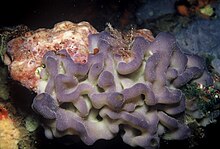| Oscarellidae | |
|---|---|
 | |
| Oscarella lobularis | |
| Scientific classification | |
| Domain: | Eukaryota |
| Kingdom: | Animalia |
| Phylum: | Porifera |
| Class: | Homoscleromorpha |
| Order: | Homosclerophorida |
| Family: | Oscarellidae Lendenfeld, 1887 [1] |
| Genera | |
see text | |
| Oscarellidae | |
|---|---|
 | |
| Oscarella lobularis | |
| Scientific classification | |
| Domain: | Eukaryota |
| Kingdom: | Animalia |
| Phylum: | Porifera |
| Class: | Homoscleromorpha |
| Order: | Homosclerophorida |
| Family: | Oscarellidae Lendenfeld, 1887 [1] |
| Genera | |
see text | |